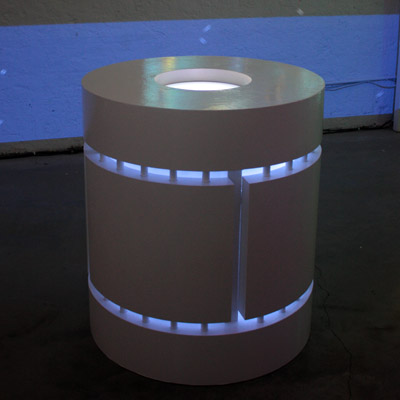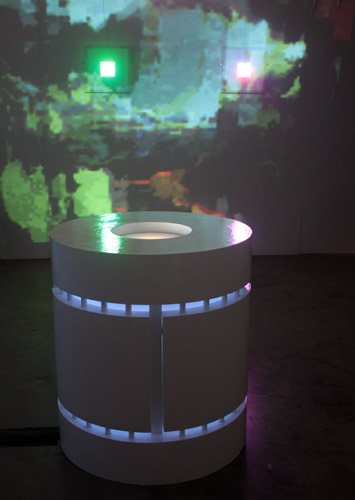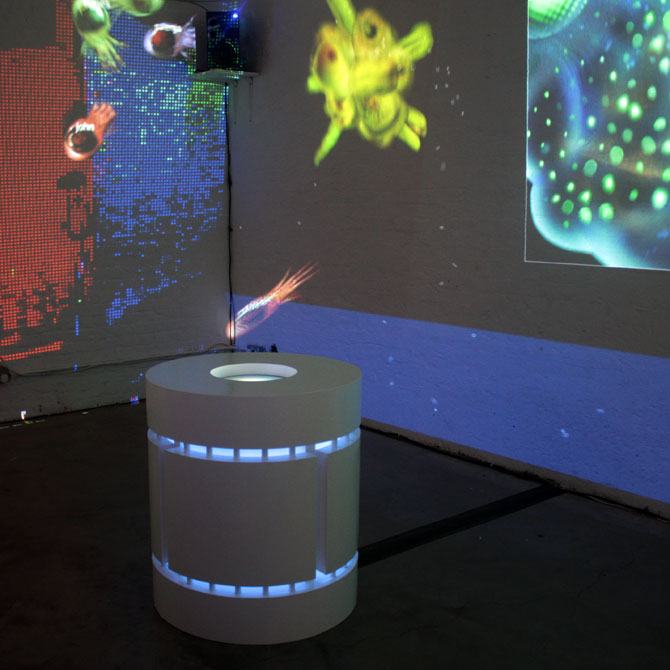10 minute audio-visual recording of ‘temporality’, four channels converted into stereo |
|
The generative audio-visual work ‘temporality’ is based on the idea of flux. In this, its natural prototype is the flowing of water in a river. If sitting on the riverbanks or floating down a river, the visual and acoustic experience of observing the water is fluid, and, if not posing imminent danger, soothing to the human eye, ear and mind. |
The ever-changing properties of this experience are intrinsically self-similar. Swirls and waves in water, as well as the correlating sounds of splashing and trickling, might occur time after time due to an underlying cause in the riverbed. Events alike can take place in seeming parallel, merging into spatial audio-visual textures with indistinguishable singularities, or as distinct events. A solitary turbulence can break the smooth surface and produce the occasional gargle; the surface of a roaring river can be white with foam. The physical properties of nature itself however ensure no repetition, only ever new manifestations of the visual or acoustic spectacle. The force responsible, the flow of water, is furthermore fundamentally changing the possibility of the reoccurring events over time. The water will slowly erode the cause of sound and movement, change the riverbed, move the stone. |

|
Change is a given and ever-present quality within the existence of time. The Greek Philosopher Heraclitus expresses this in his metaphor: “No man ever steps in the same river twice, for it is not the same river and he is not the same man.” Existence in time thus is synonymous with permanent change.
As an audio-visual composition, ‘temporality’ aims to express this fluidity and continuous transformation. Its underlying generative structure thereby enables the constant modification of the parameters comprising the quality of each individual note, as well as the visual constellation linked to the flow of sound. The momentary interplay of the notes position in time, the interval to its predecessor and successor, as |
well as its volume, pitch and spatial position, can thereby be compared to the obstacle in the riverbed producing a disturbance or noise. Like the riverbed, the parameters shift with the sounding of each note, and thus alter any potential future manifestation.
No system however functions in isolation. As an acknowledgement of this, ‘temporality’ observes the wider environment, including its spectator. Through an external input, the surrounding of the work itself has the ability to interact with the timbre of the played notes. The varying overtone constellations thus add an additional, almost subliminal fluctuation to the tonal quality of the composition.
In its entirety, ‘temporality’ therefore has no distinct spatial position, rhythm, timbre or progression, but a flow of sound ebbing and swelling within time and space. |
|

|
Installed at 'Microworld : Kinetica' a Genetic Moo project, Kinetica Art Fair, London, UK, 2014 (ø 70 cm, height 80 cm, MDF white gloss paint)
right: works by Genetic Moo, Sean Clark and Jockel Liess
bottom: works by Genetic Moo, Jockl Liess |

|
|